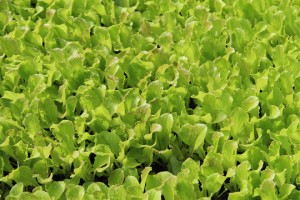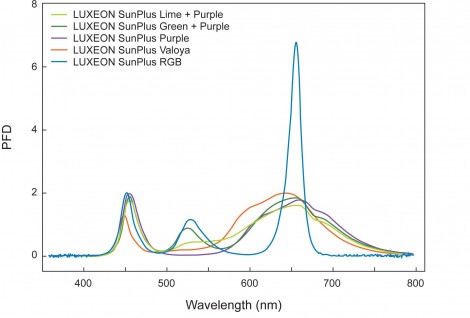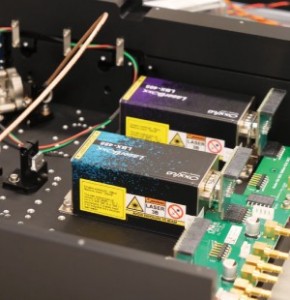
LEDs are rapidly becoming the light source of choice for indoor horticultural applications because the light spectra can be customized to meet the growth and nutritional needs of plants. In a study conducted by Tessa Pocock PhD, Senior Research Scientist at the Center for Lighting Enabled Systems and Applications (LESA), at Rensselaer Polytechnic Institute (RPI) in Troy, New York (US), researchers grew leafy greens indoors under LED lights in order to study how specific light spectra influence the concentration of nutrients. “Nothing beats the sun”, Dr. Pocock acknowledged, but growing the greens completely indoors safeguards the plants from the hazards and inconsistency of the outdoor environment, which can be weather, heat and other problems.
Under LED lights, the researchers monitored the concentrations of chlorophyll as well as two important bioactive antioxidants. The reason for the interest is that carotenoids are beneficial to human health and help protect against skin, eye, hepatic, and cardiovascular diseases. Anthocyanins, another group of bioactive antioxidants, are red, blue and purple pigments and their dietary uptake is also positively correlated with human health, such as in the treatment of vision disorders, protection against neurological disorders, reduction in incidence of cardiovascular disease, increase in cognitive ability and enhancement of antioxidant protection.
In past studies, commercially available LEDs were used and indicated that many leafy greens grown under phosphor converted (PC) LEDs had large, thin and pale leaves with consistently lower levels of chlorophyll and anthocyanins. This study was conducted to evaluate the performance of the Luxeon SunPlus Series of LEDs from Lumileds, which is a product line of direct and phosphor converted LEDs designed specifically for horticulture. What sets them apart from other horticultural LEDs is their broad range as well as the unique color points offered, including phosphor converted Lime and Purple. This range of LEDs enables the ability to select the spectrum depending on the type of plant that is being grown. The goal of the study was to determine whether recently introduced PC LEDs could improve the yield of red lettuce while producing high levels of key nutrients including anthocyanins and carotenoids.
Shining a light on lettuce
The team focused their study on the relationship or compromise between yield (above ground biomass) and nutritional quality of the red lettuce cultivar, Rouxai. Spectral photon distributions were selected to deliver photosynthetic photon flux densities (PPFDs) at the crop level with identical output in red (600-700 nm), blue (400-500 nm) and green (500-600 nm) wavelength ranges (spectral ratios of 60%:20%:20% respectively) for each fixture. There was, however, a difference in PPFD in the far-red region (700-800 nm). It was absent from the RGB direct emission spectra and ranged from 19 µmol in the Valoya PC to 25 µmol in the Luxeon SunPlus Lime + Purple fixture, 28 µmol in the Luxeon SunPlus Purple + Luxeon 3535L Green fixture and 32 µmol in the Luxeon SunPlus Purple fixture.
Two fixtures were installed in each environmentally controlled growth chamber (Adaptis 1000, Conviron) with PPFDs between 217-242 µmol/m2 s by setting light programs and/or adjusting distance to the crop (see figure below). The spectral photon distributions in the center of the chambers and in a grid spanning the growth area were measured to examine the uniformity.

Spectral photon distribution measured as photon flux density (PFD) for each light source. To enable uniform comparison, SPD was measured at the center of each chamber at the crop level.
The light analyses indicated that spectral and PPFD uniformities were poorer on average from side to side of the chambers and significantly better from front to rear. A larger installation of light bars would improve these uniformity discrepancies. The photoperiods were 16 hours/day for 14 days, the day/night temperatures were 23°C/18°C and the relative humidity was between 50% and 70%. Plant health and photochemistry was monitored using pulse amplitude chlorophyll fluorescence.
Yield, plant health and antioxidants
When the seedlings grown under the different light treatments were ready to be tested, the above-ground leaves were harvested and weighed, giving the researchers the “fresh weight” measurement. The harvested leaves were flash frozen in liquid nitrogen and tested for anthocyanin, carotenoid and chlorophyll concentrations. Yields were significantly higher in seedlings grown under Luxeon SunPlus Series Lime + Purple and Luxeon SunPlus Purple + Luxeon 3535L Green LEDs and Valoya, followed by Luxeon SunPlus Series Purple and, lastly RGB direct emission LEDs. Significantly higher anthocyanin concentrations were observed in Rouxai grown under Luxeon SunPlus Lime + Purple, Luxeon SunPlus Purple + Luxeon 3535L Green and RBG LED spectra compared to Valoya.
The study showed that lettuce grown under specific LED spectra can have both high yields and high nutritional value…
Carotenoid concentrations were not affected by the light treatments and, though not significant, the chlorophyll concentrations were consistently higher under the Luseon SunPlus Series and the RGB LEDs compared to Valoya. Plant health (FV/FM), the efficiencies of light conversion in the plant (Y(II)) and photoprotection (NPQ) were in healthy ranges indicating that there was no stress on the processes of photosynthesis in plants grown under these light treatments. The plants were well acclimated to all light sources.
Lime and green boosts nutritional value
If grown properly, salad is an excellent source of nutrients including antioxidants, which help control the level of damaging free radicals in the body. This study showed that red lettuce Rouxai grown under specific LED spectra can have significantly higher yields as well as greater concentrations of anthocyanins and good levels of carotenoids. The Luxeon SunPlus Lime + Purple LEDs and the Luxeon SunPlus Purple + Luxeon 3535L Green LEDs was successful in terms of yield (fresh weight) and antioxidant levels. The Valoya PC LEDs produced greens of comparable yield, but statistically lower levels of antioxidants, indicating that the spectral photon distribution of phosphor down conversion can have different effects on crop quality. In summary, the data suggests that growth and nutrition can be maximized using PC LEDs with strong royal blue, green and deep red components. Dr. Pocock said the data gathered in this study has served as a jumping off point to look at different parts of the spectrum to further determine how phosphor down-converted LEDS can be used to influence nutritional value of leafy crops.
Written by Anne Fischer, Managing Editor, Novus Light Technologies Today
































 Back to Enlightening Applications
Back to Enlightening Applications



























